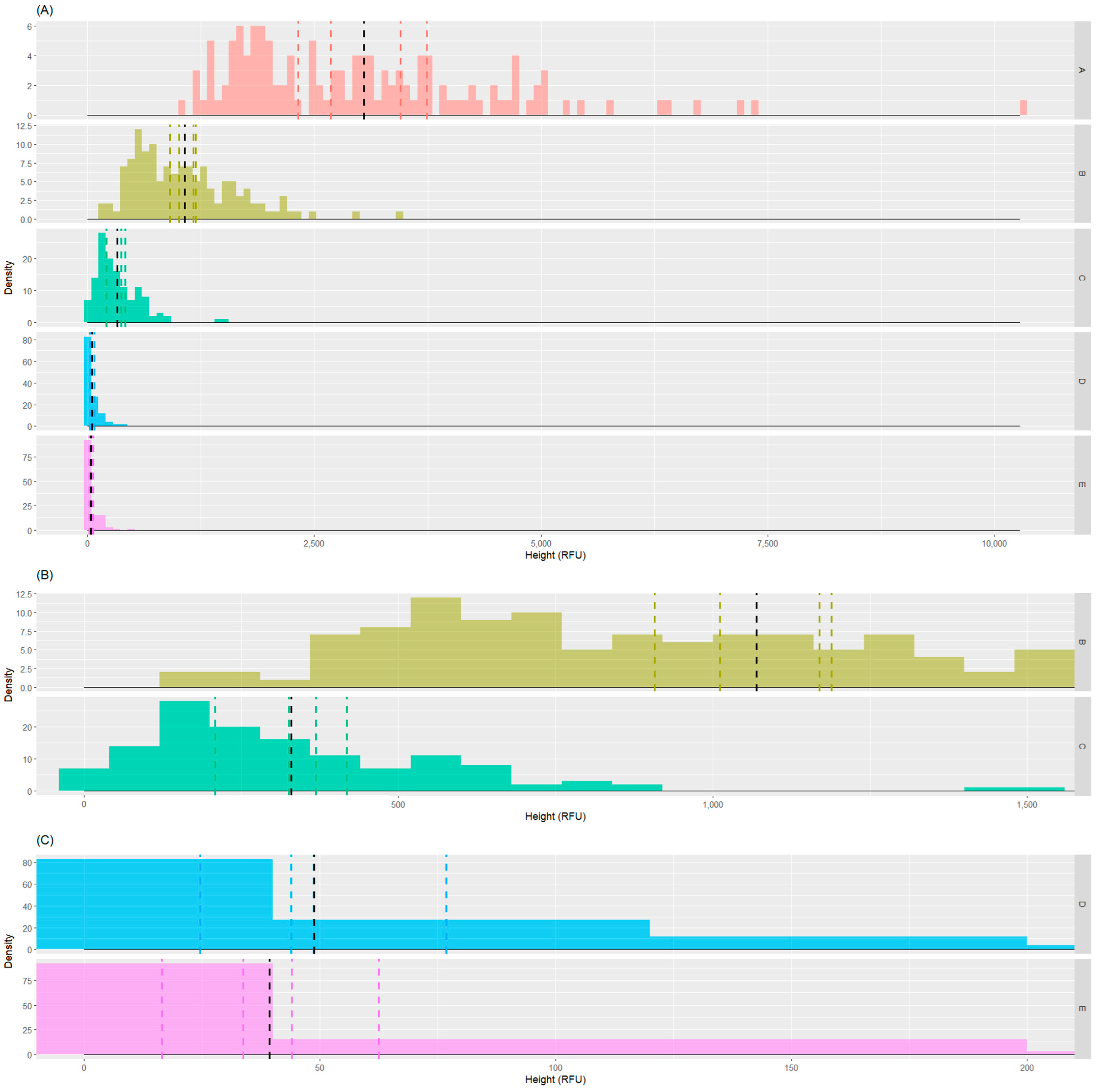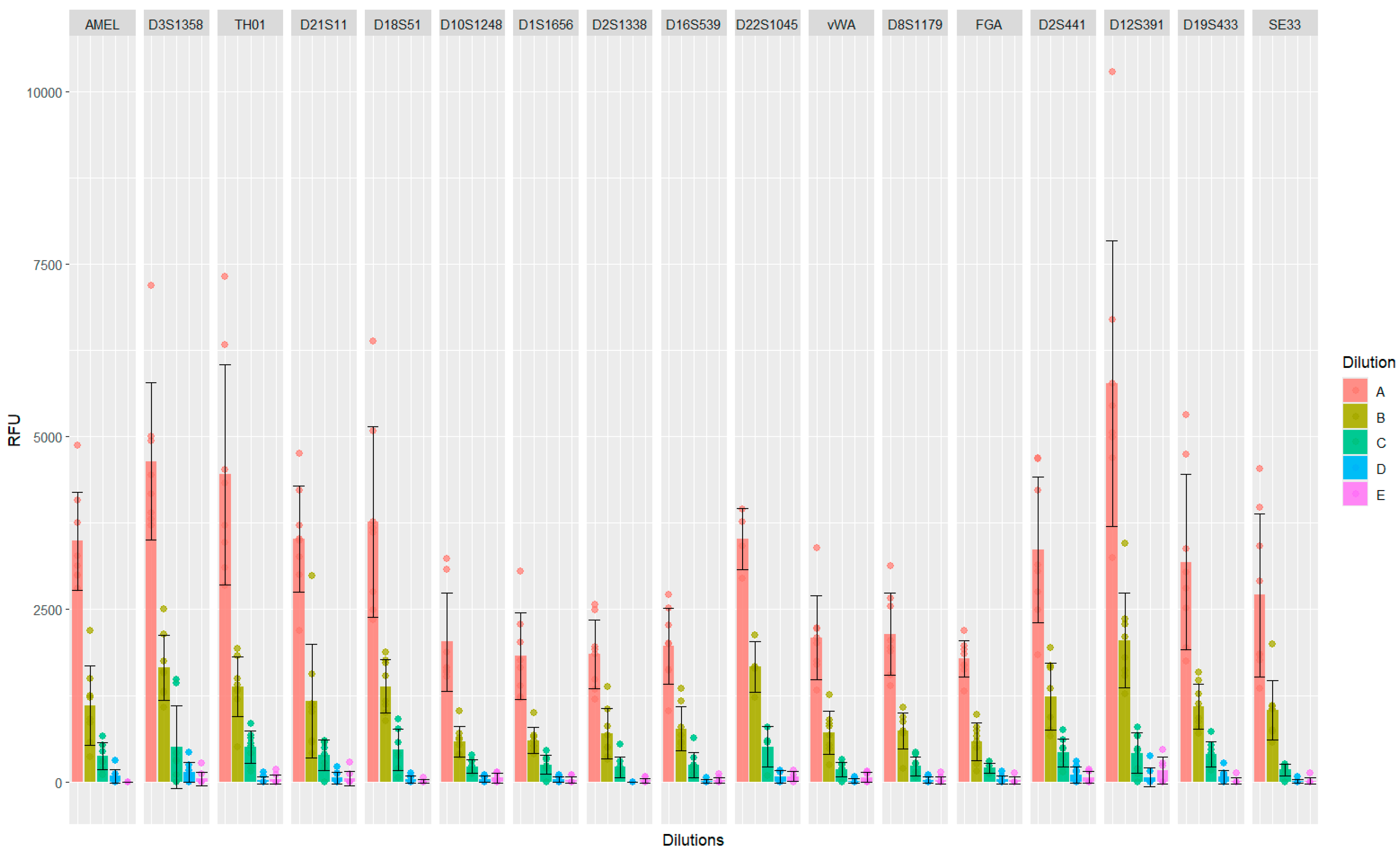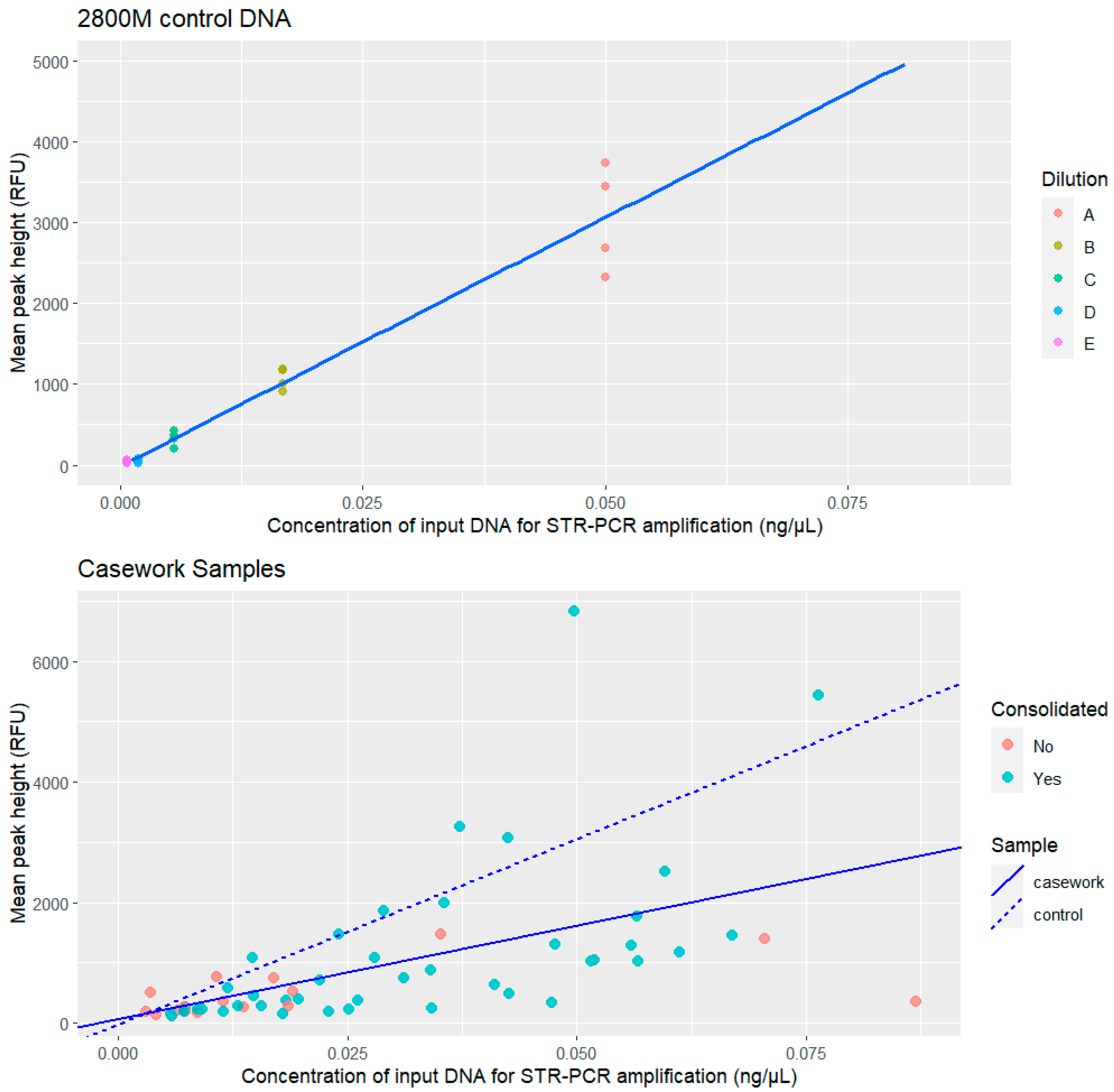The Usefulness of qPCR Data for Sample Pre-Assessment and Interpretation of Genetic Typing Results
Abstract
:1. Introduction
- (A)
- Measuring the precision of the qPCR assay for DNA templates of poor quantity but ideal quality and the degree of variability caused by non-systematic, stochastic effects.
- (B)
- Assessing how well the qPCR-measured DNA template amount is correlated with the qualitative and quantitative characteristics of an STR profile, as well as with the variability observed in STR-PCR results.
- (C)
- Evaluating the impact of DNA amount and other factors on the retrieval of an informative STR profile in real casework samples of varying concentration, degradation, and purity.
2. Materials and Methods
2.1. Control DNA Dilutions—Laboratory Protocol and Statistical Analysis
2.2. Casework Samples—Statistical Analysis
3. Results
3.1. 2800 M Control DNA Dilutions
3.1.1. PowerQuant® System accuracy, precision, and stochastic variation
3.1.2. Qualitative Analysis—Correlation of True Concentration with Profile Completeness
3.1.3. Quantitative Analysis—Correlation of True Concentration and Peak Height in RFU
3.2. Casework Samples—Variation Assessment and Prediction of Probative Value
4. Discussion
5. Conclusions
Supplementary Materials
Author Contributions
Funding
Institutional Review Board Statement
Informed Consent Statement
Data Availability Statement
Conflicts of Interest
References
- Scientific Working Group on DNA Analysis Methods (SWGDAM). Quality Assurance Standards for Forensic DNA Testing Laboratories; Federal Bureau of Investigation: Washington, DC, USA, 2020. [Google Scholar]
- Kanokwongnuwut, P.; Martin, B.; Taylor, D.; Kirkbride, K.P.; Linacre, A. How Many Cells Are Required for Successful DNA Profiling? Forensic Sci. Int. Genet. 2021, 51, 102453. [Google Scholar] [CrossRef]
- Kanagawa, T. Bias and Artifacts in Multitemplate Polymerase Chain Reactions (PCR). J. Biosci. Bioeng. 2003, 96, 317–323. [Google Scholar] [CrossRef]
- Timken, M.D.; Klein, S.B.; Buoncristiani, M.R. Stochastic Sampling Effects in STR Typing: Implications for Analysis and Interpretation. Forensic Sci. Int. Genet. 2014, 11, 195–204. [Google Scholar] [CrossRef]
- Tvedebrink, T.; Eriksen, P.S.; Mogensen, H.S.; Morling, N. Estimating the Probability of Allelic Drop-out of STR Alleles in Forensic Genetics. Forensic Sci. Int. Genet. 2009, 3, 222–226. [Google Scholar] [CrossRef]
- Tvedebrink, T.; Eriksen, P.S.; Mogensen, H.S.; Morling, N. Evaluating the Weight of Evidence by Using Quantitative Short Tandem Repeat Data in DNA Mixtures. J. R. Stat. Soc. Ser. C Appl. Stat. 2010, 59, 855–874. [Google Scholar] [CrossRef]
- Swango, K.L.; Hudlow, W.R.; Timken, M.D.; Buoncristiani, M.R. Developmental Validation of a Multiplex qPCR Assay for Assessing the Quantity and Quality of Nuclear DNA in Forensic Samples. Forensic Sci. Int. 2007, 170, 35–45. [Google Scholar] [CrossRef]
- Barbisin, M.; Shewale, J. Assessment of DNA Extracted from Forensic Samples Prior to Genotyping. Forensic Sci. Rev. 2010, 22, 199–214. [Google Scholar] [PubMed]
- Ginart, S.; Alechine, E.; Caputo, M.; Cano, H.; Corach, D.; Sala, A. Development and Validation of a Human DNA Quantification and Sex Determination Approach Based on Real Time PCR Followed by High Resolution Melting Analysis. Forensic Sci. Int. Genet. Suppl. Ser. 2015, 5, e269–e271. [Google Scholar] [CrossRef]
- Ewing, M.M.; Thompson, J.M.; McLaren, R.S.; Purpero, V.M.; Thomas, K.J.; Dobrowski, P.A.; DeGroot, G.A.; Romsos, E.L.; Storts, D.R. Human DNA Quantification and Sample Quality Assessment: Developmental Validation of the PowerQuant® System. Forensic Sci. Int. Genet. 2016, 23, 166–177. [Google Scholar] [CrossRef] [PubMed]
- Dupont, M.E.; Kampmann, M.-L.; Truelsen, D.M.; Petersen, C.B.; Andersen, J.D. Predicting the Optimal STR Profile Amplification Set up from QuantifilerTM Trio Data. Forensic Sci. Int. Genet. Suppl. Ser. 2022, 8, 205–207. [Google Scholar] [CrossRef]
- Gill, P.; Bleka, Ø.; Fonneløp, A.E. Limitations of qPCR to Estimate DNA Quantity: An RFU Method to Facilitate Inter-Laboratory Comparisons for Activity Level, and General Applicability. Forensic Sci. Int. Genet. 2022, 61, 102777. [Google Scholar] [CrossRef] [PubMed]
- Artika, I.M.; Dewi, Y.P.; Nainggolan, I.M.; Siregar, J.E.; Antonjaya, U. Real-Time Polymerase Chain Reaction: Current Techniques, Applications, and Role in COVID-19 Diagnosis. Genes 2022, 13, 2387. [Google Scholar] [CrossRef] [PubMed]
- Gouveia, N.; Brito, P.; Bogas, V.; Serra, A.; Bento, A.M.; Lopes, V.; Balsa, F.; Sampaio, L.; Bento, M.S.; Cunha, P.; et al. THE Effect of Different Levels of Degradation and DNA Concentrations on the Quality of Genetic Profiles. Forensic Sci. Int. Genet. Suppl. Ser. 2017, 6, e428–e429. [Google Scholar] [CrossRef]
- Holmes, A.S.; Houston, R.; Elwick, K.; Gangitano, D.; Hughes-Stamm, S. Evaluation of Four Commercial Quantitative Real-Time PCR Kits with Inhibited and Degraded Samples. Int. J. Leg. Med. 2018, 132, 691–701. [Google Scholar] [CrossRef] [PubMed]
- Sidstedt, M.; Rådström, P.; Hedman, J. PCR Inhibition in qPCR, dPCR and MPS—Mechanisms and Solutions. Anal. Bioanal. Chem. 2020, 412, 2009–2023. [Google Scholar] [CrossRef] [PubMed]
- Cupples, C.M.; Champagne, J.R.; Lewis, K.E.; Cruz, T.D. STR Profiles from DNA Samples with “Undetected” or Low QuantifilerTM Results. J. Forensic Sci. 2009, 54, 103–107. [Google Scholar] [CrossRef] [PubMed]
- Krenke, B.E.; Nassif, N.; Sprecher, C.J.; Knox, C.; Schwandt, M.; Storts, D.R. Developmental Validation of a Real-Time PCR Assay for the Simultaneous Quantification of Total Human and Male DNA. Forensic Sci. Int. Genet. 2008, 3, 14–21. [Google Scholar] [CrossRef] [PubMed]
- Loftus, A.; Murphy, G.; Brown, H.; Montgomery, A.; Tabak, J.; Baus, J.; Carroll, M.; Green, A.; Sikka, S.; Sinha, S. Development and Validation of InnoQuant® HY, a System for Quantitation and Quality Assessment of Total Human and Male DNA Using High Copy Targets. Forensic Sci. Int. Genet. 2017, 29, 205–217. [Google Scholar] [CrossRef] [PubMed]
- Wang, L.L.; Gaigalas, A.K.; Abbasi, F.; Marti, G.E.; Vogt, R.F.; Schwartz, A. Quantitating Fluorescence Intensity from Fluorophores: Practical Use of MESF Values. J. Res. Natl. Inst. Stand. Technol. 2002, 107, 339–353. [Google Scholar] [CrossRef]
- Timken, M.D.; Swango, K.L.; Orrego, C.; Chong, M.D.; Buoncristiani, M.R. Quantitation of DNA for Forensic DNA Typing by qPCR (Quantitative PCR): Singleplex and Multiple Modes for Nuclear and Mitochondrial Genomes, and the Y Chromosome|National Institute of Justice. Available online: https://nij.ojp.gov/library/publications/quantitation-dna-forensic-dna-typing-qpcr-quantitative-pcr-singleplex-and (accessed on 30 May 2024).
- Kelly, H.; Bright, J.-A.; Curran, J.M.; Buckleton, J. Modelling Heterozygote Balance in Forensic DNA Profiles. Forensic Sci. Int. Genet. 2012, 6, 729–734. [Google Scholar] [CrossRef]
- Karkar, S.; Alfonse, L.E.; Grgicak, C.M.; Lun, D.S. Statistical Modeling of STR Capillary Electrophoresis Signal. BMC Bioinform. 2019, 20, 584. [Google Scholar] [CrossRef] [PubMed]
- Poetsch, M.; Bajanowski, T.; Kamphausen, T. Influence of an Individual’s Age on the Amount and Interpretability of DNA Left on Touched Items. Int. J. Leg. Med. 2013, 127, 1093–1096. [Google Scholar] [CrossRef] [PubMed]
- Nordgård, O.; Kvaløy, J.T.; Farmen, R.K.; Heikkilä, R. Error Propagation in Relative Real-Time Reverse Transcription Polymerase Chain Reaction Quantification Models: The Balance between Accuracy and Precision. Anal. Biochem. 2006, 356, 182–193. [Google Scholar] [CrossRef] [PubMed]
- Walsh, P.S.; Erlich, H.A.; Higuchi, R. Preferential PCR Amplification of Alleles: Mechanisms and Solutions. Genome Res. 1992, 1, 241–250. [Google Scholar] [CrossRef] [PubMed]
- Calafell, F. The Probability Distribution of the Number of Loci Indicating Exclusion in a Core Set of STR Markers. Int. J. Leg. Med. 2000, 114, 61–65. [Google Scholar] [CrossRef] [PubMed]
- Kitayama, T.; Fujii, K.; Nakahara, H.; Mizuno, N.; Kasai, K.; Yonezawa, N.; Sekiguchi, K. Estimation of the Detection Rate in STR Analysis by Determining the DNA Degradation Ratio Using Quantitative PCR. Leg. Med. 2013, 15, 1–6. [Google Scholar] [CrossRef] [PubMed]
- Zupanič Pajnič, I.; Zupanc, T.; Balažic, J.; Geršak, Ž.M.; Stojković, O.; Skadrić, I.; Črešnar, M. Prediction of Autosomal STR Typing Success in Ancient and Second World War Bone Samples. Forensic Sci. Int. Genet. 2017, 27, 17–26. [Google Scholar] [CrossRef] [PubMed]
- Promega PowerQuant® System—Technical Manual. Available online: https://ita.promega.com/-/media/files/resources/protocols/technical-manuals/tmd/powerquant-system-technical-manual.pdf?rev=eed77410b69d43a2b0ea03fc78c7b69c&sc_lang=en (accessed on 10 May 2024).
- Promega PowerPlex® ESX 17 Fast System for Use on the Applied Biosystems® Genetic Analyzers—Technical Manual. Available online: https://www.promega.com/-/media/files/resources/protocols/technical-manuals/tmd/powerplex-esx-17-fast-system-protocol.pdf?rev=5d0f2d6d3e4f4c828caddaf26a0a76d5&sc_lang=en (accessed on 10 May 2024).
- McLaren, R.S.; Bourdeau-Heller, J.; Patel, J.; Thompson, J.M.; Pagram, J.; Loake, T.; Beesley, D.; Pirttimaa, M.; Hill, C.R.; Duewer, D.L.; et al. Developmental Validation of the PowerPlex® ESI 16/17 Fast and PowerPlex® ESX 16/17 Fast Systems. Forensic Sci. Int. Genet. 2014, 13, 195–205. [Google Scholar] [CrossRef] [PubMed]
- Willis, S.; Mc Kenna, L.; Mc Dermott, S.; O’Donell, G.; Barrett, A.; Rasmusson, B.; Nordgaard, A.; Berger, C.; Sjerps, M.; Lucena-Molina, J.; et al. ENFSI Guideline for Evaluative Reporting in Forensic Science—Strengthening the Evaluation of Forensic Results across Europe (STEOFRAE); European Network of Forensic Science Institutes: Wiesbaden, Germany, 2015. [Google Scholar]
- Scientific Working Group on DNA Analysis Methods (SWGDAM). Interpretation Guidelines for Autosomal STR Typing by Forensic DNA Testing Laboratories; Federal Beurau of Investigation: Washington, DC, USA, 2017. [Google Scholar]
- Genetisti Forensi Italiani Ge.F.I. Recommendations for Personal Identification Analysis by Forensic Laboratories; Genetisti Forensi Italiani Ge.F.I.: Genova, Italy, 2018. [Google Scholar]
- Benschop, C.C.G.; van der Beek, C.P.; Meiland, H.C.; van Gorp, A.G.M.; Westen, A.A.; Sijen, T. Low Template STR Typing: Effect of Replicate Number and Consensus Method on Genotyping Reliability and DNA Database Search Results. Forensic Sci. Int. Genet. 2011, 5, 316–328. [Google Scholar] [CrossRef]
- Pääbo, S. Amplifying Ancient DNA. In PCR Protocols: A Guide to Methods and Applications; Academic Press: San Diego, CA, USA, 1990. [Google Scholar]
- Yeung, S.H.I.; Seo, T.S.; Crouse, C.A.; Greenspoon, S.A.; Chiesl, T.N.; Ban, J.D.; Mathies, R.A. Fluorescence Energy Transfer-Labeled Primers for High-Performance Forensic DNA Profiling. Electrophoresis 2008, 29, 2251–2259. [Google Scholar] [CrossRef]
- Demchenko, A.P. Collective Effects Influencing Fluorescence Emission. In Advanced Fluorescence Reporters in Chemistry and Biology II: Molecular Constructions, Polymers and Nanoparticles; Demchenko, A.P., Ed.; Springer: Berlin/Heidelberg, Germany, 2010; pp. 107–132. ISBN 978-3-642-04701-5. [Google Scholar]




| Dilution | True Concentration (ng/μL) | Mean [Auto] (ng/μL) | SD [Auto] (ng/μL) | MAPE | CV |
|---|---|---|---|---|---|
| A | 0.05 | 0.049648 | 0.002829 | 4.0% | 0.057 |
| B | 0.0167 | 0.015598 | 0.000502 | 6.0% | 0.032 |
| C | 0.0055 | 0.006011 | 0.001326 | 19.7% | 0.221 |
| D | 0.00185 | 0.001912 | 0.000413 | 14.6% | 0.216 |
| E | 0.000617 | 0.00064 | 0.000306 | 33.2% | 0.478 |
| Dilution | Rep 1 | Rep 2 | Rep 3 | Rep 4 | Consensus Profile | Mean (Rep 1–4) | SD |
|---|---|---|---|---|---|---|---|
| A | 100% | 100% | 100% | 100% | 100% | 100% | 0 |
| B | 100% | 100% | 100% | 100% | 100% | 100% | 0 |
| C | 91.2% | 94.1% | 94.1% | 94.1% | 94.1% | 93.4% | 1.45% |
| D | 44.1% | 38.2% | 26.5% | 23.5% | 38.2% | 33.1% | 9.71% |
| E | 17.6% | 32.4% | 32.4% | 38.2% | 32.4% | 30.2% | 8.8% |
| Dilution | Mean Height (RFU) | SD (RFU) | MAPE | CV |
|---|---|---|---|---|
| A | 3046.66 | 1503.66 | 35.6% | 0.494 |
| B | 1068.92 | 585.29 | 42.4% | 0.548 |
| C | 329.79 | 250.61 | 52.1% | 0.760 |
| D | 48.75 | 82.86 | 128.5% | 1.7 |
| E | 39.34 | 76.91 | 145% | 1.955 |
Disclaimer/Publisher’s Note: The statements, opinions and data contained in all publications are solely those of the individual author(s) and contributor(s) and not of MDPI and/or the editor(s). MDPI and/or the editor(s) disclaim responsibility for any injury to people or property resulting from any ideas, methods, instructions or products referred to in the content. |
© 2024 by the authors. Licensee MDPI, Basel, Switzerland. This article is an open access article distributed under the terms and conditions of the Creative Commons Attribution (CC BY) license (https://creativecommons.org/licenses/by/4.0/).
Share and Cite
Onofri, M.; Severini, S.; Tommolini, F.; Lancia, M.; Gambelunghe, C.; Carlini, L.; Carnevali, E. The Usefulness of qPCR Data for Sample Pre-Assessment and Interpretation of Genetic Typing Results. Genes 2024, 15, 744. https://doi.org/10.3390/genes15060744
Onofri M, Severini S, Tommolini F, Lancia M, Gambelunghe C, Carlini L, Carnevali E. The Usefulness of qPCR Data for Sample Pre-Assessment and Interpretation of Genetic Typing Results. Genes. 2024; 15(6):744. https://doi.org/10.3390/genes15060744
Chicago/Turabian StyleOnofri, Martina, Simona Severini, Federica Tommolini, Massimo Lancia, Cristiana Gambelunghe, Luigi Carlini, and Eugenia Carnevali. 2024. "The Usefulness of qPCR Data for Sample Pre-Assessment and Interpretation of Genetic Typing Results" Genes 15, no. 6: 744. https://doi.org/10.3390/genes15060744






